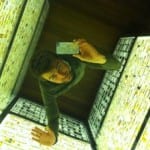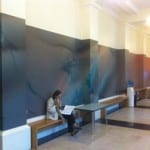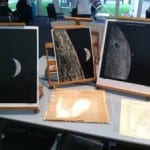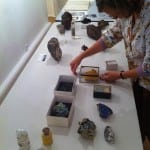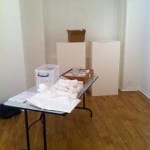A week in the life of a Curator
By Nick J Booth, on 18 September 2013
People often ask me what it is I do for a job. “Well” I answer, “I’m a curator”.
“Yes, but what do you actually do?”
“I curate a collection, I help look after it”.
“Yes but what do you ACTUALLY do all day?”
It’s a good question, and one to which the answer is never really that simple. What I ‘actually do’ varies from week to week, and depends upon what I have to do, what I need to do, and what I have time to do. So I thought I would write a blog as a way of answering.
Last week I made a point of recording exactly what I was up to between Monday and Friday, and tried to take a few more photos that I would normally. I should say that I did not particularly plan for this week to be one I blogged about, and I resisted the urge to book in lots of important sounding meetings. I had planned to use a stepometer during the week, to see how far I walked, but sadly couldn’t get my hands on one in time.
So, my week…
At UCL I help to look after the Teaching and research Collections. I generally tell people these are the collections without a public museum space (although that’s not strictly true for the Geology Collections). There are 14 Collections that make up the Teaching and Research Collections, which are spread across UCL’s main campus (and beyond). I’m primarily responsible for 10 of these collections.
Monday AM – My week starts in the same way I suspect many other people’s do – with checking e-mails. I do this every day, but won’t record it because it would be very boring. Later in the morning I went to retrieve three 1950’s Edison Dictaphone tubes from our Physiology store which have been selected to be part of a research project called ‘100 hours’, which aims to set 10 researchers up with 10 objects and give them 100 hours to work with them. I was also able to head down to the cloisters to view a very special exhibition put up over the weekend by our exhibitions manager and an academic from the Planetary Centre at UCL called ’10 Miles of Mars’. This literally shows a 10 mile stretch of the surface of mars on the cloister wall, and is well worth a visit if you are near UCL.
PM – And my day was done! I had taken the afternoon off to go to a museum where I used to work to help them draw up a collections policy as part of their application for accreditation (a National Museum Standard scheme). We discussed what and how the museum should collect for the future, and it was actually really interesting.
Tuesday AM – Tuesday started with a reminder in my calendar that it was the 99th anniversary of the death of Dr Johnston-Lavis, an important geological collector who had bequeathed his impressive vulcanolgical collection to UCL. I have several dates relating to personalities that are represented in the Teaching and Research collections in my diary, and try to put something on social media to commemorate them. I visited another of our stores, to talk to a conserver who is doing some work for us on a collection of 19th century phrenological heads. Finally I had to take a meteorite off display in the rock room, to lend to a team from the Petrie Museum who used it as part of a science busking event at the Festival of Planets, being held at UCL. They used it to illustrate the fact that they have the world’s oldest metal artefact in their collection, beads made from meteorite iron.
PM – After the Petrie had finished their event the Planetary Centre at UCL had a two hour slot for a public engagement event, featuring NASA images from the UCL Regional Planetary Image Facility and staffed by PhD students. Not for the first time the Art Museum kindly lent us some easels. Once this was set up I had to head over to the Grant for a meeting with our Digital Resources Manager, other curatorial staff from UCL Museums and an outside consultant to discuss database keywording. We use an Adlib database for most of the collections at UCL, and this was the first meeting aimed at looking at how we record the concepts related to an object. Finally after this I returned to help take down the pop-up.
Wednesday AM – I was really looking forward to today because I had put aside the whole day to work on our database. I spent most of the morning working on the Geological Minerals database checking that new acquisitions are properly recorded. I am not a geologist, so work like this is good because it allows me to get a sense of what we have in the collection and the type of language geologists use. I also left the office for an hour to help hang three pictures in the lobby of the Chemistry department, which were given to UCL by the Prime Minister of Japan to mark the 150th anniversary of a group of Japanese Students coming to study at UCL.
PM- In the afternoon I was in the Grant Museum to man the desk while the regular staff were away on an away day. We had over 70 visitors while I was there and I even sold a few postcards. I also took this time as an opportunity to work on the Science and Engineering Collections database, mostly getting images of the objects onto the database and linking them to objects. Getting photos on the database allows easier identification of objects. It also helps as a quick audit tool, as I know that all objects with photos attached have their location recorded.
Evening – On Wednesday evening I took part in a gallery workshop at GV Art Gallery, as part of a show ‘Nature Reserves’ to which the Geology Collections (and the Grant) had loaned objects. The other Geology Curator, Wendy Kirk, and I took a selection of objects from the Johnston-Lavis Collection to the gallery to illustrate our talk.
Thursday AM – The day started with some running around again, picking up sponges from our conservation team and taking them over to the conserver working on the phrenological heads. Then we had a Profile Group meeting, where staff from the different areas of UCL Museums meet to talk about marketing and profile-raising projects (coming soon: toilet door posters…). After this I had to help put away the specimens used the evening before. This is a job that always takes a lot longer than it should, and the temptation is always to put it off. However that’s how objects get lost so we always try to get objects back into their proper storage as soon as possible after an event.
PM – The afternoon was again spent helping with another pop-up. This time I also took the opportunity to ‘test’ some of the Lego Mars rovers on another stall, all in the name of scientific research obviously…
Friday AM – I spent most of this morning going through objects that had been lent for a student exhibition project at the Institute of Education in 2005, and which had been returned to us the week before.
PM – Between 1 – 3 I was on duty in the Rock Room, during its public opening hours. Although it was quieter than my time in the Grant Museum we still had a few people in. We get a surprising number of art and design students visiting, looking for inspiration from the forms and shapes of our specimens. After my shift was over I went back to GV Art Gallery to collect the objects we had lent the exhibition, two drawers of geological specimens. This was a relatively painless experience as the gallery is quite close to UCL and is used to working with museums.
During my week I visited three of the museums on campus (Art, Geology and the Grant), one commercial gallery (GV Art). I also visited the Chemistry, Engineering and Physiology Departments, as well as our main store room several times. I spent 7 hours doing public-facing jobs, at the Grant and Rock Room, and another 3 at the evening event. I worked with Geology, Chemistry, Engineering, Physics and a phrenological head collection. Variety is the spice of life!
Nick Booth is one of the Curators of the Teaching and Research Collections.
 Close
Close


